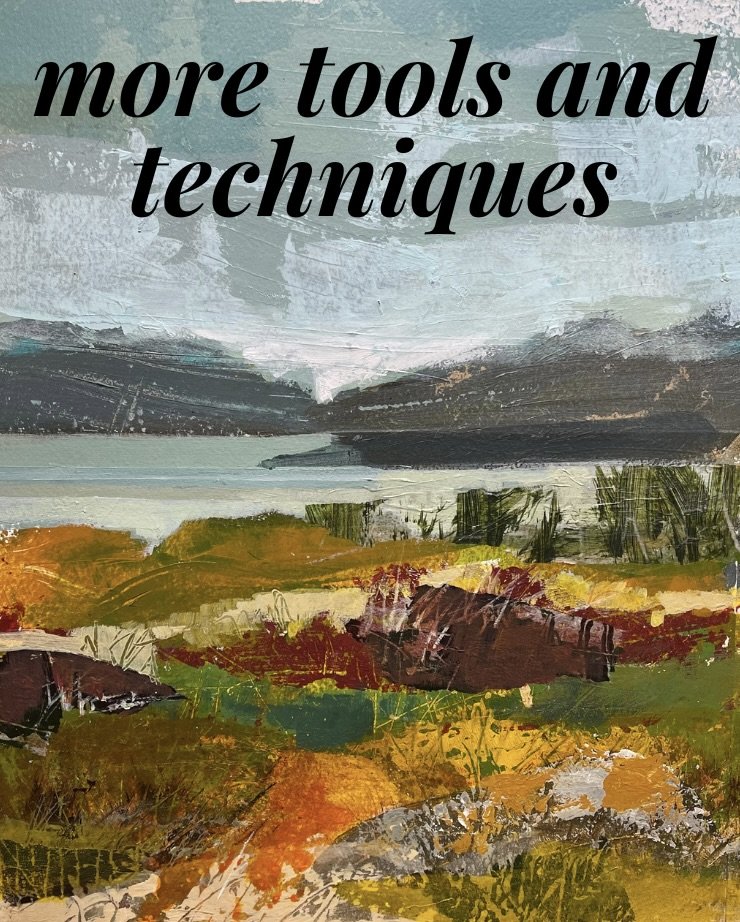
Abstracting Landscape
(with collage, mixed media, and acrylic)
What students say about Abstracting Landscape
I just finished your course “Abstracting the Landscape.” It was worth every penny. Writing to you from the beautiful Niagara area. Just wanted to say thank you!
Suzanne S.
I'm currently doing this class and it is super amazing! I am really enjoying it! Katie R.
Check out the preview below.
Click on any lock symbol to purchase course for $150 CAN
Abstracting Landscape
This course is designed to help you move your paintings from representational into more expressive evocative landscapes. Through a series of videos and notes you’ll start to see landscapes differently and learn some fun tools and techniques to loosen up and help you work more intuitively.
-
-
Paths to Abstraction
We look at different painters’ work and talk about how we can abstract landscape: perspective, colour, surface (pattern) extreme simplification.
We look at different painters’ work and talk about how we can abstract landscape: perspective, colour, surface (pattern) extreme simplification.
-
Getting to know your images with Thumbnail Sketches and Notans
In this video we use quick thumbnail sketches and notans to understand composition and value of our landscape images, before we start on paintings.
In this video we use quick thumbnail sketches and notans to understand composition and value of our landscape images, before we start on paintings.
-
Simplifying with Value Painting
Working with black and white and one other colour, we’ll talk about the relationship between value and colour and develop a landscape simplified through structure and a harmonious palette.
Working with black and white and one other colour, we’ll talk about the relationship between value and colour and develop a landscape simplified through structure and a harmonious palette.
-
-
-
Collage as a bridge to abstraction
In this exercise, working with photo images we’ll create collages which capture the visual language, palette and surface textures of a landscape.
In this exercise, working with photo images we’ll create collages which capture the visual language, palette and surface textures of a landscape.
-
-
-
Creating a larger abstract landscape from a small collage
In this first video we’ll look at unusual ways to get the paint on the canvas: cards, scrapers, Squeegees, putty knives…
In this first video we’ll look at unusual ways to get the paint on the canvas: cards, scrapers, Squeegees, putty knives…
-
2. Making and adding collage papers
Collage papers can add an element of abstraction and surprise, capturing marks and creating blocks of colour that allow us to slow down and make intuitive decisions as we add them to the painting.
Collage papers can add an element of abstraction and surprise, capturing marks and creating blocks of colour that allow us to slow down and make intuitive decisions as we add them to the painting.
-
3. Resolving our painting
In the final video of this series, we discover the return to simplification— painting out active areas with opaques to provide quiet space and create paths of light.
In the final video of this series, we discover the return to simplification— painting out active areas with opaques to provide quiet space and create paths of light.
-
a few more tools and techniques
I share a few more tips with you: masking with drawing gum and cut out masks, foam roller, rope brushes, monoprint transfer of paint, glazing with acrylic inks…
I share a few more tips with you: masking with drawing gum and cut out masks, foam roller, rope brushes, monoprint transfer of paint, glazing with acrylic inks…
-
a wrap up with a few last ideas on continuing your abstract landscape practice
-
Retake this course?
Retaking this course from the beginning will reset all of your tracked progress.
Every painting is an abstract, because even in representational work, we are taking the 3 dimensional world and making it into an abstract 2 dimensional world. Learning to work in the abstract asks us to work intuitively: we can ask ourselves not what we want the painting to be, but what does it want to become. We respond to the new choices which are presented at each stage as the painting evolves. This can feel scary at first, but once you get used to it and begin to trust the process, it can make painting more joyful and allow more room for your own personal vision to develop.
-
